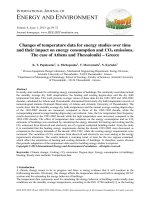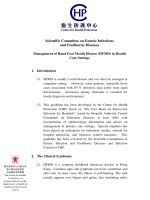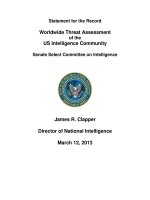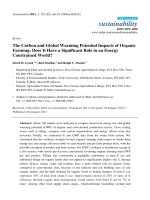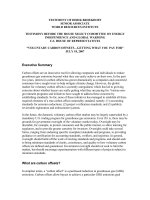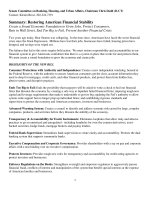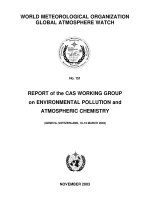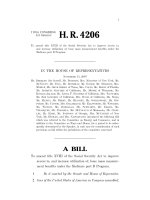TESTIMONY BEFORE THE HOUSE SELECT COMMITTEE ON ENERGY INDEPENDENCE AND GLOBAL WARMING U.S. HOUSE OF REPRESENTATIVES pptx
Bạn đang xem bản rút gọn của tài liệu. Xem và tải ngay bản đầy đủ của tài liệu tại đây (258.53 KB, 15 trang )
TESTIMONY OF DERIK BROEKHOFF
SENIOR ASSOCIATE
WORLD RESOURCES INSTITUTE
TESTIMONY BEFORE THE HOUSE SELECT COMMITTEE ON ENERGY
INDEPENDENCE AND GLOBAL WARMING
U.S. HOUSE OF REPRESENTATIVES
“VOLUNTARY CARBON OFFSETS—GETTING WHAT YOU PAY FOR”
JULY 18, 2007
Executive Summary
Carbon offsets are an innovative tool for allowing companies and individuals to reduce
greenhouse gas emissions beyond what they can easily achieve on their own. In the past
two years, interest in carbon offsets has grown dramatically as companies and concerned
consumers have sought ways to help mitigate climate change. However, the global
market for voluntary carbon offsets is currently unregulated, which has led to growing
concerns about whether buyers are really getting what they are paying for. Various non-
government programs and initiatives have sought to address these concerns by
establishing standards. So far, none of these initiatives has managed to establish all three
required elements of a true carbon offset commodity standard, namely: (1) accounting
standards for emission reductions; (2) project verification standards; and (3) publicly
reviewable registration and enforcement systems.
In the future, the domestic voluntary carbon offset market may be largely superseded by a
mandatory U.S. trading program for greenhouse gas emissions. Even if it is, there may be
grounds for government oversight of the voluntary market today. Oversight may be
desirable, for example, to protect consumers and the public interest, to allow learning for
regulators, and to provide greater certainty for investors. Oversight could take several
forms, ranging from endorsing specific (complete) standards and programs, to providing
guidance or certification for accounting standards, verifiers, and registries. In general,
oversight should build off the work of existing standards and programs, and should seek
to bring minimum standards of clarity, consistency, and quality to how voluntary carbon
offsets are defined and guaranteed. Government oversight should not seek to limit the
market, but should encourage experimentation with different types of projects subject to
minimum standards.
What are carbon offsets?
In simplest terms, a “carbon offset” is a purchased reduction in greenhouse gas (GHG)
emissions. Carbon offsets allow buyers to achieve a particular GHG emissions goal
W O R L D R E S O U R C E S I N S T I T U T E
without having to reduce their own emissions directly.
1
They are useful wherever direct
emission reductions would be too costly or difficult. A well-designed market for carbon
offsets can allow companies, organizations, and individuals to achieve GHG emission
reductions at lower cost, which ultimately means they can afford do more to help avert
climate change.
Carbon offsets can have other benefits as well. Offset revenues can help spur investment
in innovative technologies that help transition the economy towards lower GHG
emissions. Many types of projects that reduce GHG emissions, such as renewable energy,
energy efficiency, transportation, and forestry projects, have significant secondary
environmental and social benefits.
Although the very first carbon offset project was voluntary,
2
much of the work to
establish real markets for carbon offsets has been done in the context of designing
regulatory programs. Many experimental carbon offset projects were undertaken in the
1990s, for example, in order to inform negotiations under the Framework Convention on
Climate Change about the design of an international GHG emissions trading system.
Experience from these projects led to the creation of the “Clean Development
Mechanism” (CDM) under the Kyoto Protocol, which now constitutes the largest
functioning market for carbon offsets. Through the CDM, emission reductions in
developing countries can be used to offset emissions in industrialized countries, whose
total emissions are capped. Credits issued for these offsets allow industrialized countries
to increase their emissions (effectively increasing the “cap”), on the premise that net
emissions to the atmosphere remain the same. The CDM is also envisioned as a way to
help less developed countries grow sustainably through the transfer and deployment of
beneficial technologies and practices. A separate Kyoto Protocol mechanism, called
“Joint Implementation” (JI) recognizes carbon offsets from projects in industrialized
countries.
The global market for carbon offsets has grown dramatically over the last few years since
the CDM was formally established (Figure 1). In 2006, the total market value of CDM
carbon offset credits was $5.5 billion.
1
Because the effect of greenhouse gases is global, it does not matter where they are reduced.
2
See Faeth, P., M. Trexler, and J.M. Kramer, 1989. Forestry as a Response to Global Warming: An
Analysis of the Guatemala Agroforestry and Carbon Sequestration Project. World Resources Institute,
Washington, D.C.
2
W O R L D R E S O U R C E S I N S T I T U T E
Figure 1. Annual Volumes of Carbon Offset Transactions in Millions of Tons of
Carbon Dioxide Equivalent
Source: Capoor and Ambrosi 2007, State and Trends of the Carbon Market 2007. World Bank Institute,
Washington, D.C.
What is the voluntary carbon offset market?
Although the majority of carbon offset purchases in the world today are by companies or
governments seeking to comply with the Kyoto Protocol, growing concerns about climate
change have led to an interest in carbon offsets among a much wider group of buyers.
Demand for “voluntary” carbon offsets comes from two distinct groups:
1. Wholesale buyers. These are mainly companies seeking to reduce GHG
emissions for reasons of social responsibility, public relations, or anticipation of
future regulatory requirements (either to gain firsthand experience with carbon
offset trading prior to regulation, or in hopes of gaining recognition under a future
regime). In some cases, these buyers are purchasing and retiring offsets on behalf
of customers. For example, they may offset the GHG emissions associated with
the production or consumption of their products in order to offer a product that is
“carbon neutral.” Wholesale buyers currently dominate the voluntary carbon
offset market; according to a recent survey, they were responsible for over 60
percent of voluntary offset purchases in 2006.
3
Around 20 percent of wholesale
purchases consist of carbon offsets purchased on behalf of customers.
4
2. Retail buyers. These buyers consist of smaller organizations or individuals
seeking to offset the GHG emissions for which they are personally responsible.
They may be travelers who offset emission associated with their airplane flights;
individuals or organizations who offset the emissions they cause in order to
become “carbon neutral”; or conference and event organizers who wish to offer
3
Harris, E., 2006. Working Paper on the Voluntary Carbon Market: Current and Future Market Status,
and Implications for Development Benefits. International Institute for Environment and Development,
London, October 2006.
4
Ibid.
3
W O R L D R E S O U R C E S I N S T I T U T E
“carbon neutral” events. According to the IIED, these buyers are responsible for
less than 40 percent of voluntary offset purchases, but they are a fast growing
segment. The number of retail carbon offset providers in the United States and
internationally has grown markedly in just the past two years.
5, 6, 7
The voluntary carbon offset market overall is growing rapidly. Worldwide voluntary
offset purchases amounted to around six million tons of CO
2
-equivalent emission
reductions in 2005, growing to over 10 million tons in 2006.
8
The total market value
globally for the voluntary offset market is now estimated at over $100 million, with
prices for GHG emission reductions ranging anywhere from $1 to nearly $80 per ton of
CO
2
-equivalent.
9
Although projections are always difficult in a fledgling market,
expectations are that the global market could reach a size of 400 million tons by 2011
(including 250 million tons in the United States),
10, 11
with a market value possibly
rivaling that of today’s CDM market.
What kinds of projects are being funded through the voluntary
carbon offset market?
There are a vast number of technologies and practices that can be employed to reduce
GHG emissions for the purpose of generating offsets. In addition, GHG emissions can be
offset through certain kinds of land use and forestry practices that remove CO
2
from the
atmosphere. According to a survey from 2006, projects involving land use and forestry
practices are in fact the most common type being funded by voluntary offset purchases.
12
The next most common type of project involves renewable energy production, followed
by demand-side energy efficiency improvements (Table 1).
13
The proportion of actual
emission reductions or removals may be different from the numbers of projects, however,
since certain kinds of projects produce far greater volumes of CO
2
-equivalent reductions
than others. This is especially true of projects involving non-CO
2
gases (such as methane
or HFCs), whose contributions to atmospheric warming are many times higher than CO
2
on a per weight basis.
5
Hamilton, K., et al., 2006. Offsetting Emissions: A Business Brief on the Voluntary Carbon Market.
Business for Social Responsibility and Ecosystem Marketplace, San Francisco.
6
Clean Air-Cool Planet, 2006. A Consumers’ Guide to Retail Carbon Offset Providers. Clean Air-Cool
Planet, Portsmouth, New Hampshire.
7
Kollmuss, A., and B. Bowell, 2006. Voluntary Offsets for Air-Travel Carbon Emissions: Evaluations and
Recommendations of Voluntary Offset Companies. Tufts Climate Initiative, Boston.
8
Capoor, K. and P. Ambrosi, 2007. State and Trends of the Carbon Market 2007. World Bank Institute,
Washington, D.C.
9
Ibid.
10
ICF International, 2006. Voluntary Carbon Offsets Market: Outlook 2007, ICF International: London.
11
Trexler , M., 2007. “US Demand?” presentation at the Point Carbon “Carbon Market Insights 2007”
conference, Copenhagen, 13-15 March 2007.
12
Harris, E., 2006. Working Paper on the Voluntary Carbon Market: Current and Future Market Status,
and Implications for Development Benefits. International Institute for Environment and Development,
London, October 2006.
13
Ibid.
4
W O R L D R E S O U R C E S I N S T I T U T E
Table 1. Types of Projects Funded by Voluntary Carbon Offset Purchases
Type of Project Percentage by
Number of Projects
Land Use and Forestry 56%
Renewable Energy 25%
Demand-Side Energy Efficiency 10%
Fugitive Emissions (e.g., methane capture) 6%
Supply-Side Energy Efficiency 3%
Source: Harris, E., 2006. Working Paper on the Voluntary Carbon Market: Current and Future Market
Status, and Implications for Development Benefits. International Institute for Environment and
Development, London, October 2006.
Can the voluntary carbon offset market really help to address climate
change?
The answer to this question is partly a matter of perspective. Current scientific evidence
suggests that to mitigate the risk of dangerous climate change, global GHG emissions
must be reduced by 60 to 80 percent by mid-century,
14
equivalent to many billions of
tons of annual reductions. In this context, the contribution of the voluntary carbon offset
market – even under the most optimistic demand scenarios – is likely to be small. Instead,
globally coordinated mandatory policies will be needed to drive significant near-term
reductions in emissions and achieve long-term stabilization of atmospheric GHG
concentrations.
Voluntary carbon offset markets may still have a role to play. In simplest terms, the
magnitude of effort required is large, and every little bit helps. Voluntary carbon offsets
allow companies and individuals to reduce emissions beyond what they could achieve on
their own, by tapping into project opportunities that would otherwise go unexploited. The
benefits of carbon offsets can be multiplied to the extent they drive innovation in
emission-reducing technologies and create new markets for them. Finally, the voluntary
offset market can play a very significant role in educating the public about climate
change and about effective and affordable ways to mitigate it. Ultimately, however,
mandatory emissions trading systems, particularly if they allow offset projects, are likely
to subsume the advantages of a voluntary regime.
Won’t demand for voluntary carbon offsets evaporate once we have
mandatory regulations to control greenhouse gas emissions?
It makes sense that when governments implement policies requiring reductions in GHG
emissions, public interest in further voluntary emissions reductions will diminish. It is
14
Intergovernmental Panel on Climate Change, 2007. Climate Change 2007 – Mitigation of Climate
Change: Working Group III Contribution to the Intergovernmental Panel on Climate Change Fourth
Assessment Report. Cambridge University Press.
5
W O R L D R E S O U R C E S I N S T I T U T E
quite likely that much of the current demand for voluntary carbon offsets is driven by
buyers’ concerns that governments are not going far enough yet to address climate
change. Nevertheless, it also seems likely that substantial demand for voluntary GHG
emission reductions can exist even where there are regulatory requirements. “Carbon
neutrality” has become a goal for many companies seeking to attract customers by
providing environmentally friendly products and services. Likewise, growing awareness
about climate change has sparked an interest among many individuals to do their part to
help solve the problem. Given the magnitude of emission reductions required, it is quite
reasonable to expect that many firms and individuals will continue to seek ways to cost-
effectively mitigate their “carbon footprints” even after mandatory GHG limits are in
place. In fact, a significant segment of the demand for voluntary carbon offsets exists in
Europe, where limits on GHG emissions are already in place.
Perhaps a more central question is whether a separate system for voluntary offsets will be
required once a mandatory regime is in place. If a mandatory regime encompasses all
sectors and all types of projects, this would not be necessary. However, if a mandatory
program were to begin with limited coverage of project types, there is still likely to be a
place for a voluntary system, in large part to serve as a proving ground for new types of
technologies and projects.
Why are some people concerned about the voluntary carbon offset
market?
Voluntary carbon offsets have been traded in relatively small volumes and on a
demonstration basis since the late 1980s. Some organizations, such as the Climate Trust
in Oregon, have many years of experience in purchasing and retiring offsets on behalf of
clients or customers (the Climate Trust was established in 1997 to assist new power
plants in Oregon to meet a state regulatory requirement for net CO
2
emissions). As the
data above indicate, however, there has been a dramatic increase in the last two years in
the number of voluntary offset transactions, with an accompanying expansion in the
number of suppliers. Unlike the Kyoto Protocol’s CDM offset market, however, where
there are clear rules, standards, and oversight mechanisms, the voluntary market is
operating in a regulatory vacuum. Many observers are concerned about the lack of
standards and oversight for voluntary carbon offsets, and wonder whether buyers are
truly getting what they pay for, i.e., real emission reductions.
The issue is not so much a question about the integrity of carbon offset providers. Most
suppliers in the market today are well-meaning private companies and non-profit
organizations that sincerely want to help their customers do good for the environment.
The questions that arise are really about the definition of the “commodity” being sold.
Carbon offsets are an intangible good, and as such their value and integrity depend
entirely on how they are defined, represented, and guaranteed. What the market lacks are
common standards for how such representations and guarantees are made and enforced.
6
W O R L D R E S O U R C E S I N S T I T U T E
What elements are necessary for a carbon offset standard?
Much of the literature on carbon offsets (and nearly all aspiring “standards”) point out
that credible offsets must be “real, surplus, permanent, verifiable, and enforceable” – or
some variation of these terms.
15
Different sources do not always agree on the definitions
of these criteria, however, and having a “standard” for carbon offsets really depends on
how they are interpreted. What the criteria boil down to are three things, all of which
need some form of official certification or oversight to create a true carbon offset
“commodity”: (1) accounting standards; (2) monitoring and verification standards; and
(3) registration and enforcement systems.
1. GHG Emission Reduction Accounting Standards
Accounting standards address the actual quantification of GHG reductions that carbon
offsets represent. Accounting standards are a first-order requirement for ensuring that a
ton of emission reductions from one project is the same as a ton from another, and ensure
that offsets are “real, surplus, and permanent.”
As might be expected, a lot of work has been done over the years to develop accounting
standards for offsets. In December 2005, the World Resources Institute (WRI) and the
World Business Council for Sustainable Development (WBCSD) published the
Greenhouse Gas Protocol for Project Accounting (“Project Protocol”), which provides a
general framework for quantifying emission reductions from offset projects, based on the
accumulated knowledge of an international group of experts from businesses,
governments, and environmental groups.
16
It has since been supplemented with two
sector-specific accounting protocols, one for land use and forestry projects, the other for
renewable energy and energy efficiency projects.
17,
18
These documents provide an
internationally recognized basis for the elaboration of detailed accounting standards for
15
The concept of emission offsets originated under the “New Source Review” program established by the
United States Clean Air Act of 1977. Under this program, offsets are required to be “real, creditable,
quantifiable, permanent, and federally enforceable.” These basic criteria have been modified and adopted in
general form under a variety of other offset programs, including programs for carbon offsets. The “surplus”
criterion is generally added to distinguish offset reductions from reductions that would occur for other
reasons. The criteria that carbon offsets must be “real, surplus, permanent, verifiable, and enforceable” are
now the most frequently cited and are, for example, enshrined in the Memorandum of Understanding
establishing the Regional Greenhouse Gas Initiative in the northeast United States. See, for example, Liepa,
I., 2002. Greenhouse Gas Offsets: An Introduction to Core Elements of an Offset Rule. Climate Change
Central, Alberta, Canada.
16
Greenhalgh, S., D. Broekhoff, and F. Daviet, 2005. The Greenhouse Gas Protocol for Project
Accounting. World Resources Institute and World Business Council for Sustainable Development,
Washington, D.C. and Geneva.
17
Greenhalgh, S., F. Daviet, and E. Weninger, 2006. The Land Use, Land-Use Change, and Forestry
Guidance for GHG Project Accounting. World Resources Institute, Washington, D.C.
18
Broekhoff, D., 2007 (forthcoming). Guidelines for Quantifying GHG Reductions from Grid-Connected
Electricity Projects. World Resources Institute and World Business Council for Sustainable Development,
Washington, D.C. and Geneva.
7
W O R L D R E S O U R C E S I N S T I T U T E
specific types of projects.
19
The largest body of standard accounting methodologies
established to date exists under the Kyoto Protocol’s Clean Development Mechanism.
Very few of the carbon offsets sold in the voluntary market, however, explicitly follow
the WRI/WBCSD Project Protocol or CDM methodologies.
Probably the most important part of offset project accounting is making a determination
about “additionality” – that is, whether the purchase of emission reductions really
enabled (or induced) a project to happen, or whether the purchase is essentially being
wasted on a project that would have happened anyway (in which case its emission
reductions effectively have zero value for the purpose of offsetting emissions). Many
would say that “additionality” is the key to the environmental integrity of an offset
purchase – but it is also vexingly hard to determine in many cases. It has proven very
difficult to establish true standards for additionality, and even the CDM requires
regulators to make essentially subjective judgments about it on a case-by-case basis. Two
recent reports on the voluntary carbon offset market suggest that many providers do not
clearly indicate how they determine the additionality of their projects.
20, 21
A standard set
of guidance or criteria would aid the credibility of offset markets tremendously.
22
2. Monitoring and Verification Standards
Monitoring and verification standards are required to ensure that offset projects perform
as expected and to quantify their actual emission reductions. Monitoring protocols are
generally developed in conjunction with accounting protocols. Verification usually
requires the services of a third-party professional verifier, or a government regulator. If
third-party verifiers are used, they need to meet minimum qualifications and have some
expertise related to the types of projects they are verifying. This is one of the biggest gaps
in the voluntary carbon offset market right now. Although there is a generic international
standard for the accreditation of verifiers (ISO 14065), and there are certainly verifiers
with well-established reputations for competence and integrity, a publicly accountable
certification process for verifiers could greatly enhance the credibility of the voluntary
offset market.
Finally, verification does not mean very much without clear accounting and monitoring
standards against which to verify. This emphasizes the need to adopt common accounting
and reporting standards.
3. Registration and Enforcement Systems
19
The WRI/WBCSD GHG Protocol: A Corporate Accounting and Reporting Standard is the most widely
used international accounting tool for government and business leaders to understand, quantify, and
manage greenhouse gas emissions. For more information, see
.
20
Clean Air-Cool Planet, 2006. A Consumers’ Guide to Retail Carbon Offset Providers. Clean Air-Cool
Planet, Portsmouth, New Hampshire.
21
Kollmuss, A., and B. Bowell, 2006. Voluntary Offsets for Air-Travel Carbon Emissions: Evaluations and
Recommendations of Voluntary Offset Companies. Tufts Climate Initiative, Boston.
22
For further insight into establishing “additionality” standards, see Trexler, M., D. Broekhoff, and L.
Kosloff, 2006. “A Statistically-Driven Approach to Offset-Based GHG Additionality Determinations: What
Can We Learn?” in Sustainable Development Law & Policy, Volume VI, Issue 2, Winter 2006.
8
W O R L D R E S O U R C E S I N S T I T U T E
One concern about the voluntary offset market as it continues to grow is the possibility
that suppliers may sell the same reductions to multiple buyers, because there is no central
authority to track their transactions. Related to this, questions can arise in some instances
about who “owns” emission reductions and who in fact has the right to sell them. In some
cases, multiple parties may conceivably lay claim to the same reduction. For example,
both the manufacturer and the installer of energy efficient lightbulbs might want to claim
the emission reductions caused by the lightbulbs – as might the owners of the power
plants where the reductions actually occur. Right now, establishing the right to an offset
reduction largely consists of making public marketing claims and trying to exclude others
from doing the same.
This is another area where some kind of oversight and public accountability may be
desirable. Key requirements (which might be established either though federal policy, or
more realistically, through non-profit or commercial enterprises) are:
1. A registry (or registries) containing publicly available information that can be
used to uniquely identify offset projects.
2. In the same registry system, a mechanism to assign unique identifiers (e.g., serial
numbers) to offset credits generated by each project, and a system to transparently
track their ownership and status (i.e., whether they’ve been “used” to offset
emissions by someone).
3. Contractual or legal standards that clearly identify the original “owner” of
emission reductions, and that specify compensation mechanisms for GHG
removals or reductions that are reversed (e.g., re-emitted from destroyed forests)
or not actually achieved.
Is anyone trying to create standards for the voluntary carbon offset
market?
To address the current shortcomings in the voluntary carbon offset market, a number of
organizations involved in the industry have initiated efforts over the last two years to
develop voluntary standards. The first such standards were the WRI/WBCSD Project
Protocol (noted above) and the ISO 14064 standard.
23
The WRI/WBCSD Project
Protocol is a set of guidance documents for offset project accounting, while the ISO
14064 standard is a checklist of essential accounting elements. Neither is a full-fledged
standard for determining the emission reductions for specific technologies or practices –
although both together provide a toolkit for policymakers to create such standards.
Furthermore, while the ISO standard does cover verification (and accreditation of
verifiers under ISO 14065), neither the WRI/WBCSD Project Protocol nor the ISO
standards cover all three of the required elements for a fully standardized carbon offset
commodity noted above.
Other standard-setting efforts have tackled different pieces of the puzzle. The California
Climate Action Registry (CCAR) is developing a series of accounting standards for
23
ISO 14064, International Organization for Standardization, Geneva, Switzerland, 2006.
9
W O R L D R E S O U R C E S I N S T I T U T E
specific types of offset projects, compatible with the WRI/WBCSD Project Protocol. So
far they have approved protocols for forestry sequestration projects and agricultural
methane digesters.
24
Projects can be registered with CCAR, and CCAR maintains a list of
accredited verifiers. CCAR does not yet have a facility for tracking trades or retiring
offset credits, although this may be developed in the future (possibly as part of the
recently announced multi-state Climate Registry).
25
Similarly, the U.S. Environmental
Protection Agency Climate Leaders Program has begun developing a set of standards for
quantifying emission reductions for several types of projects.
26
These standards are still
in draft form, however, and would need to be supplemented with monitoring and
verification standards and a registry to establish a credible carbon offset commodity.
The Center for Resource Solutions (CRS) has recently completed work on a “Green-e
GHG Product Standard.”
27
Under this standard, CRS will certify carbon offsets that are
created under programs that already have credible accounting and verification standards
in place. The CRS standard does seek to provide an enforcement mechanism (by
requiring offset marketers to disclose information to buyers) but relies on other programs
for accounting and verification rules.
The Climate Group (based in London), the International Emissions Trading Association,
and the World Economic Forum are currently developing (with stakeholder input) a
global “Voluntary Carbon Standard” (VCS) that will in principle cover accounting rules,
verification standards (including accreditation of verifiers), and the establishment of a
registration and enforcement system.
28
Initially, the VCS will most likely reference CDM
accounting and verification standards, although it may incorporate other standards over
time. Its credibility will largely rest on the decisions of designated verifiers, which will
effectively be responsible for its enforcement in place of a central regulatory authority.
The Chicago Climate Exchange (CCX) has operated a voluntary trading system since
2003 that includes a carbon offset component. In principle CCX offsets can be used to
voluntarily offset emissions for companies and individuals who are not CCX members,
just as CDM offsets can (some retail providers already offer to retire CCX offsets on
behalf of customers). The CCX program includes proprietary accounting rules,
verification standards, and a registry to track credits and project information. One of the
criticisms of the CCX, however, is that little information is publicly available about its
standards and individual projects.
Other voluntary carbon offset standards, including the “CDM Gold Standard,” primarily
reference the CDM’s accounting and verification requirements. They do not provide
separate accreditation of verifiers, nor have they established strong registry or
enforcement systems.
24
See
25
See
26
See
27
See
28
See
10
W O R L D R E S O U R C E S I N S T I T U T E
In short, most of the “standards” developed under voluntary initiatives to date do not
incorporate all of the elements of a true carbon offset commodity standard. Some of these
initiatives could develop into full-fledged standards and oversight programs, but are not
there yet (e.g., CCAR or Climate Leaders). The VCS may cover all the bases when it is
launched, but it may also have a loose oversight structure. The CCX currently has a
functioning offset commodity standard, but suffers from lack of transparency and public
accountability.
Might these efforts eventually be sufficient, or is there a need for
government oversight?
One answer to this question is “time will tell.” Pieces of a full voluntary offset standard
are coming together under various initiatives, and it is possible that the market will sort
itself out as these pieces either fall away or become incorporated into a single program or
set of programs. Currently, however, the proliferation of standards – many of which are
incomplete – is creating more confusion than clarity.
This risk with a “wait and see” approach is that the market may never cohere around a
single standard or program. Even fully established standards are not all alike. Differences
in accounting and verification rules – especially with respect to additionality – can
significantly affect the “quality” of carbon offsets offered to the market. Many would
argue that it is not necessary to have unified quality standards, and that buyers should be
able to discriminate between different quality offsets according to their needs. But given
the complexity of carbon offsets as a commodity, it is not clear that typical consumers
could effectively distinguish “good” quality from “bad” – especially unsophisticated
buyers in the retail offset market. Allowing multiple standards of varying quality could
just as easily sow confusion and skepticism among the buying public, a process that
already seems to be underway.
The consequences of skepticism about the voluntary offset market are hard to predict. In
the extreme case, the risk is that it could cause the voluntary market to dissolve and foster
opposition to the development of mandatory offset programs. This could mean the loss of
significant low-cost opportunities for mitigating climate change. Avoiding this outcome
may require some kind of government oversight to ensure a minimum level of consumer
protection in the voluntary carbon offset.
Ultimately, the government’s focus should be on developing strong mandatory offset
programs that incorporate all three required elements of a standard. As mentioned above,
the true value of the voluntary market may be as a proving ground for innovative project
types not incorporated in a mandatory regime. At the end of the day, however, we are still
talking about a commodity whose primary purpose is to benefit the public good by
helping to mitigate climate change. This alone argues for public oversight in shaping the
standards that define the commodity’s quality.
11
W O R L D R E S O U R C E S I N S T I T U T E
Why should the government regulate voluntary carbon offset markets
when future mandatory programs (e.g., a federal cap-and-trade
system) could supersede them?
In principle, there is no reason why voluntary carbon offset markets and mandatory
regulatory programs cannot coexist. The real question is whether mandatory regulations
might render unnecessary the standards and systems established under a voluntary market
– and whether that would be a bad thing.
In fact, the prospect of mandatory regulations creates real risks for the voluntary market.
If a CO
2
emissions cap is placed on power plants, for example, no offset projects
claiming to reduce emissions from the power grid (e.g., renewables or energy efficiency
projects) could continue to make that claim (because a ton of emissions reduced would
simply free up an allowance that another power plant could use to emit more). Moreover,
a mandatory emissions trading program could establish carbon offset rules and compel
voluntary offset purchasers to abide by those same rules.
Of course, one response to these risks is to say “let the buyer beware.” There are several
reasons, however, why active regulation of the voluntary market today may make sense:
• Buyers are looking for offsets now. As the market data cited earlier indicate,
demand in the voluntary carbon offset market is growing rapidly. The desire
among consumers to voluntarily contribute to climate change mitigation is
something that should be harnessed and encouraged. Waiting until a full-fledged
mandatory trading program before establishing offset standards could stunt the
market before it has a chance to develop and undermine receptivity to offsets in
the future. And given that a public good is at stake, there may be sound reasons
for intervention on the grounds of consumer protection.
• Voluntary offsets can inform the development of mandatory trading systems.
Initiating an oversight process for the voluntary offset market could actually assist
with the development of a future mandatory program, by giving regulators hands-
on experience with the evaluation and establishment of accounting standards,
verification requirements, and registry systems.
• Mandatory and voluntary markets won’t necessarily be redundant. It is not
necessarily the case that a mandatory program will fully supersede voluntary
offset programs. Under a mandatory program, for example, the government might
decide to allow only a limited number offset project types, leaving other more
experimental emission-reducing opportunities open to voluntary demand. While
government oversight of the voluntary market could be less restrictive (and
should not discourage innovation), there may still be some need for minimum
quality standards.
• Current oversight could provide certainty for the future. One reason for
government oversight today is to provide some assurance about the interaction of
voluntary offset markets and mandatory programs in the future. Official
endorsement of projects in certain sectors, for example, could indicate to
voluntary offset buyers and sellers where they can safely invest their money to
avoid conflict with future regulations. Oversight of the voluntary offset market
12
W O R L D R E S O U R C E S I N S T I T U T E
could even form the basis of an “early action” crediting program for potentially
regulated businesses. Policymakers must decide, however, whether they are
willing to establish such precedents before a mandatory program is fully
developed.
What form should government regulation or oversight take?
There are basically two ways the federal government could help bring consistency and
credibility to the voluntary carbon offset market. The first would be to officially endorse
offset credits from a particular program or trading system with its own credible oversight
and enforcement mechanisms. The second would be to provide guidance, oversight,
and/or enforcement for the voluntary market directly.
Endorsing a Particular Program or Trading System
The United Kingdom Department for Environment, Food, and Rural Affairs (DEFRA)
floated a "best practice" guideline for voluntary offsets earlier this year recommending
that only officially certified CDM credits, or allowances issued under the European
Union Emissions Trading System, should be used for voluntary offsets. DEFRA’s
argument was essentially that only offset credits (or tradable allowances) from these
mandatory programs currently meet all the required elements for a credible carbon offset
commodity.
Something similar could make sense for the United States. The question would be which
program(s) to endorse or certify. Currently, only the Chicago Climate Exchange meets
the basic requirements for a full standard, but its lack of transparency has raised questions
about its credibility. Another alternative might be to endorse carbon offsets credits issues
under the Northeast Regional Greenhouse Gas Initiative (RGGI), a multi-state cap-and-
trade program for greenhouse gases. The RGGI program, however, will not be
operational until 2009. Other programs mentioned above might qualify as well as they are
further developed or launched.
A “best practice” guideline like this would of course not be binding, but could serve as a
kind of quality benchmark for the market and promote consistency.
Establishing Guidance and Oversight for the Voluntary Carbon Offset Market
Direct oversight of the voluntary carbon offset market could take several forms, with
varying degrees of involvement. In essence, however, it would involve ensuring that a
consistent set of basic building blocks for a credible carbon offset standard are in place:
accounting standards, verification standards, and registration and enforcement systems.
The objective of government oversight should be to bring clarity and consistency to how
voluntary carbon offsets are defined and guaranteed. Any regulation or guidance should
build off the work of existing standards and programs.
13
W O R L D R E S O U R C E S I N S T I T U T E
1. Accounting Standards
As noted above, several organizations are developing offset project accounting protocols
applicable to specific types of projects in the United States. These protocols and others
could be tapped to form the basis of a federal government “best practice” standard for
voluntary carbon offsets. Protocols to evaluate for inclusion would include those
developed by CCAR, the U.S. EPA Climate Leaders Program, RGGI, and the CCX.
CDM accounting methodologies could also be considered, particularly for projects
located in other countries, where protocols designed for the United States may not apply.
There is some overlap in coverage among these programs’ various protocols (each of
them, for example, has a separate protocol for agricultural methane projects), and any
differences will ultimately have to be reconciled. Federal guidance designating “best
practice” protocols for the voluntary offset market could be tremendously helpful.
As noted above, one of the most critical carbon offset accounting issues involves making
determinations about “additionality.” U.S. programs have adopted a fundamentally
different approach to additionality than the CDM, based on setting benchmarks against
which projects can be objectively evaluated, rather than asking regulators to make
subjective judgments about individual projects. Both approaches are potentially
legitimate, but a standard set of guidance for additionality would greatly aid the
credibility of the voluntary market.
2. Monitoring and Verification Standards
Of existing U.S. standards and programs, only CCAR and the CCX maintain lists of
accredited verifiers. Other standards rely primarily on CDM-accredited verifiers. The
VCS will formally accredit verifiers once it is launched. Nevertheless, the credibility of
the voluntary carbon offset market would be enhanced by an official government
accreditation program, identifying qualified verifiers for specific types of projects in the
United States. A publicly accountable accreditation process could lend confidence to the
voluntary market, and would not have to preempt or conflict with lists of verifiers
maintained by existing programs.
3. Registration and Enforcement
Various registries are being developed that could perform essential disclosure and
tracking functions for the voluntary carbon offset market. CCAR is one such registry
(although it does not yet track the trading and retirement of credits), and the nascent
multi-state Climate Registry will be another. The VCS plans to certify a registry (or
multiple registries) to handle disclosure and tracking functions. The CCX maintains a
registry, but does not publicly disclose information.
It would not make sense to create an entirely new registry for the voluntary carbon offset
market. Nevertheless, there may be a compelling government interest to certify registries
to ensure that they disclose essential information, and also to ensure that a proliferation of
14
W O R L D R E S O U R C E S I N S T I T U T E
independent registries does not lead to the double registering and selling of the same
GHG emission reductions.
Finally, the voluntary offset market would benefit from a clarification in law or
regulation of who owns the “property” rights to specific types of emission reductions.
Are there certain types of projects that should or should not be used
to offset GHG emissions?
The universe of potential carbon offset projects is both large and varied. If the goal of
carbon offset markets is to achieve emission reductions at the lowest possible cost, then it
makes sense to cast a wide net and include as many project types as possible.
Nevertheless, most carbon offset programs expressly forbid projects with potential
adverse social or environmental impacts (including, in nearly all cases, projects involving
nuclear power), and it makes sense to adopt this as a minimum standard.
Some observers argue that carbon offsets should only come from projects whose
emission reductions are easy to quantify and verify. This is a good general rule, but it
should not be interpreted too strictly. Generally, there is a tradeoff between projects that
are “slam dunks” for offset credibility, but have few other redeeming qualities (e.g., HFC
destruction), and those whose effects are difficult to quantify or verify, but have many
secondary benefits (e.g., forestry). As noted previously, the ultimate value of the
voluntary offset market may be as a tool for demonstrating innovative types of projects in
areas that would otherwise be unexploited. The role of government oversight should be to
ensure that accounting and verification methods follow basic standards for quality,
without categorically excluding projects that may have multiple positive benefits.
Ultimately, a “portfolio” approach makes sense. Currently, the voluntary carbon offset
market appears dominated by forestry projects, which tend to face significant
quantification uncertainties. This points up the need for credible accounting guidelines,
such as those developed under the WRI/WBCSD Project Protocol. The CDM market has
faced an opposite problem, however, where a large quantify of offsets have come from
projects whose reductions are easily quantified, but whose sustainable development
benefits are minimal.
15
